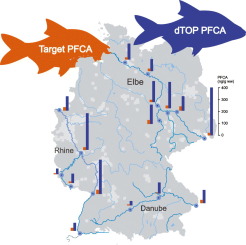Exploring unknown per- and polyfluoroalkyl substances in the German environment – The total oxidizable precursor assay as helpful tool in research and regulation
Göckener, Bernd; Fliedner, Annette; Rüdel, Heinz; Fettig, Ina; Koschorreck, Jan
Science of The Total Environment 782 (2021), 146825; online 29 March 2021
Abstract
Limnetic, marine and soil samples of the German environmental specimen bank (ESB) were analyzed for per- and polyfluoroalkyl substances (PFAS) using target analysis and a modified total oxidizable precursor (TOP) assay (direct TOP assay (dTOP)) that works without prior extraction.
Target analysis determined ∑PFAS concentrations in bream livers of 8.7–282 μg kg−1 wet weight (ww) in 2019, with highest contaminations in the Rhine and lower Elbe. In bream fillet, concentrations were lower (<0.5–10.6 μg kg−1 ∑PFAS). Contamination of suspended particulate matter (SPM) was highest in the upper Elbe downstream the Czech border (5.5 μg kg−1 dry weight (dw) in 2018). Herring gull eggs from the North and Baltic Seas showed ∑PFAS levels around 53.0–69.6 μg kg−1 ww in 2019. In soil, concentrations ranged between <0.5 and 4.6 μg kg−1 dw with highest levels in the Dueben Heath near Leipzig and the low mountain range Solling. PFOS dominated in most samples. Of the targeted precursors, only FOSA, EtFOSAA, MeFOSAA, 6:2-FtS and 6:2 diPAP were found. Replacement chemicals (ADONA, HFPO-DA, F-53B) were not detected.
The dTOP assay revealed that considerable amounts of precursors were present at most riverine sampling sites. Particularly high precursor concentrations were observed in samples from the Upper Elbe at the Czech border and the Upper and Middle Rhine. In herring gull eggs and most soil samples, though, concentrations of precursors were low. Time trend analysis showed decreasing trends for most detected PFAS since 2005. In SPM, however, C4-C6 perfluoroalkyl carboxylic acids seem to increase indicating growing use of precursors based on shorter fluorinated chains.
The results demonstrate that target analysis detects only a minor fraction of the PFAS burdens in environmental samples. The dTOP assay can support risk assessment and chemical monitoring with more comprehensive exposure data of the actual contamination.
doi: 10.1016/j.scitotenv.2021.146825
